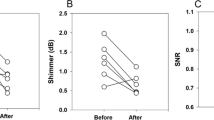Abstract
Unilateral vocal fold paralysis can result in incomplete glottic closure, compromising the vocal efficiency and increasing the risk of aspiration. The glottic gap can be reduced by medialization thyroplasty. Both silicone and titanium implants have been described to be efficient in the improvement of the vocal outcome. The aim of this study was to assess the vocal outcome after medialization thyroplasty using silicone and titanium implants and to compare the results of the two implanted materials using prospective sequential cohort study. 24 patients underwent medialization thyroplasty, performed under local anaesthesia with intravenous sedation: 10 patients were included in the silicone cohort and 14 in the titanium cohort. All patients underwent vocal assessment preoperatively and postoperatively, using the Voice Handicap Index, the GRBASI scale, maximum phonation time and the Dysphonia Severity Index. Postoperative analysis of the entire population showed statistically significant improvement for the Voice Handicap Index, maximum phonation time, Dysphonia Severity Index and the parameters G, B and A of the GRBASI scale (83% follow up). Subgroup analysis showed a statistically significant greater improvement of Voice Handicap Index of the titanium cohort compared with the silicone cohort. Improvement of maximum phonation time, Dysphonia Severity Index and GRBASI scale of the titanium cohort was greater than improvement of the silicone cohort, but this difference was not statistically significant. Both silicone and titanium medialization implants showed improvement of vocal outcome, the results of the titanium implant being superior.




Similar content being viewed by others
Notes
Written permission from Heinz Kurz GmbH, Germany has been obtained to use Fig. 1 for publication.
References
Remacle M, Friedrich G, Dikkers FG, de Jong F (2003) Phonosurgery of the vocal folds: a classification proposal. Eur Arch Otorhinolaryngol 260:1–6
Friedrich G, Remacle M, Birchall M, Marie JP, Arens C (2007) Defining phonosurgery: a proposal for classification and nomenclature by the Phonosurgery Committee of the European Laryngological Society (ELS). Eur Arch Otorhinolaryngol 264:1191–1200
Koufman JA (1986) Laryngoplasty for vocal cord medialization: an alternative to Teflon. Laryngoscope 96(7):726–731
Sasaki CT, Leder SB, Petcu L, Friedman CD (1990) Longitudinal voice quality changes following Isshiki thyroplasty type I: the Yale experience. Laryngoscope 100(8):849–852
Sridhara SR, Ashok KG, Raghunathan M, Mann SBS (2003) To study voice quality before and after thyroplasty type I in patients with symptomatic unilateral vocal cord paralysis. Am J Otolaryngol 24(6):361–365
Bihari A, Mészáros K, Reményi A, Lichtenberger G (2006) Voice quality improvement after management of unilateral vocal cord paralysis with different techniques. Eur Arch Otorhinolaryngol 263(12):1115–1120
Isshiki N, Okamura H, Ishikawa T (1975) Thyroplasty type I (lateral compression) for dysphonia due to vocal cord paralysis or atrophy. Acta Otolaryngol 80:465–473
Isshiki N (2000) Progress in laryngeal framework surgery. Acta Otolaryngol 120:120–127
Leder SB, Sasaki CT (1994) Long-term changes in vocal quality following Isshiki thyroplasty type I. Laryngoscope 104(3):275–277
Montgomery WW, Montgomery SK (1997) Montgomery thyroplasty implant system. Ann Otol Rhinol Laryngol Suppl 170:1–16
Storck C, Brockmann M, Schnellmann E, Stoeckli SJ, Schmid S (2007) Functional outcome of vocal fold medialization thyroplasty with a hydroxyapatite implant. Laryngoscope 117:1118–1122
Cummings CW, Purcell LL, Flint PW (1993) Hydroxylapatite laryngeal implants for medialization. Preliminary report. Ann Otol Rhinol Laryngol 102:843–851
McCulloch TM, Hoffman HT (1998) Medialization laryngoplasty with expanded polytetrafluoroethylene. Surgical technique and preliminary results. Ann Otol Rhinol Laryngol 107:427–432
Suehiro A, Hirano S, Kishimoto Y, Tanaka S, Ford CN (2009) Comparative study of vocal outcomes with silicone versus Gore-Tex thyroplasty. Ann Otol Rhinol Laryngol 118(6):405–408
Sittel C, Friedrich G, Zorowka P, Eckel HE (2002) Surgical voice rehabilitation after laser surgery for glottic carcinoma. Ann Otol Rhinol Laryngol 11:493–499
Friedrich G (1999) Titanium vocal fold medializing implant: introducing a novel implant system for external vocal fold medialization. Ann Otol Rhinol Laryngol 108(1):79–86
Schneider B, Denk DM, Bigenzahn W (2003) Acoustic assessment of the voice quality before and after medialization thyroplasty using the titanium vocal fold medialization implant (TVFMI). Otolaryngol Head Neck Surg 128(6):815–822
Schneider B, Denk DM, Bigenzahn W (2003) Functional results after external vocal fold medialization thyroplasty with the titanium vocal fold medialization implant. Laryngoscope 113(4):628–634
Dejonckere PH, Clemente P et al (2001) Committee on Phoniatrics of the European Laryngological Society (ELS). A basic protocol for functional assessment of voice pathology, especially for investigating the efficacy of (phonosurgical) treatments and evaluating new assessment techniques. Guideline elaborated by the Committee on Phoniatrics of the European Laryngological Society (ELS). Eur Arch Otorhinolaryngol 258(2):77–82
Jacobson BH, Johnson A, Grywalski C, Sirbergleit A, Jacobson G, Benninger MS (1997) The Voice Handicap Index (VHI): development and validation. Am J Speech Lang Pathol 6:66–70
De Bodt M, Jacobson S, Musschoot S et al (2000) De Voice Handicap Index. Een instrument voor het kwantificeren van de psychosociale consequenties van stemstoornissen (in Dutch). Logopedie 13:29–33
Wuyts F, De Bodt M, Molenberghs G et al (2000) The Dysphonia Severity Index: an objective measure of vocal quality based on a multiparameter approach. J Speech Lang Hear Res 43:796–809
Friedlander P, Aygene E, Kraus DH (1999) Prevention of airway complications in thyroplasty patients requiring endotracheal intubation. Ann Otol Rhinol Laryngol 108:735–737
Lin HW, Bhattacharyya N (2009) Incidence of perioperative complications in patients with previous medialization thyroplasty. Laryngoscope 119(4):675–678
Conflict of interest statement
The authors declare that they have no conflict of interest.
Author information
Authors and Affiliations
Corresponding author
Rights and permissions
About this article
Cite this article
van Ardenne, N., Vanderwegen, J., Van Nuffelen, G. et al. Medialization thyroplasty: vocal outcome of silicone and titanium implant. Eur Arch Otorhinolaryngol 268, 101–107 (2011). https://doi.org/10.1007/s00405-010-1327-7
Received:
Accepted:
Published:
Issue Date:
DOI: https://doi.org/10.1007/s00405-010-1327-7




